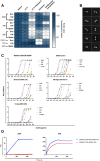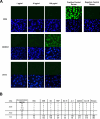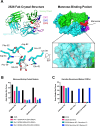Isolation and characterization of IgG3 glycan-targeting antibodies with exceptional cross-reactivity for diverse viral families
- PMID: 39292703
- PMCID: PMC11410209
- DOI: 10.1371/journal.ppat.1012499
Isolation and characterization of IgG3 glycan-targeting antibodies with exceptional cross-reactivity for diverse viral families
Abstract
Broadly reactive antibodies that target sequence-diverse antigens are of interest for vaccine design and monoclonal antibody therapeutic development because they can protect against multiple strains of a virus and provide a barrier to evolution of escape mutants. Using LIBRA-seq (linking B cell receptor to antigen specificity through sequencing) data for the B cell repertoire of an individual chronically infected with human immunodeficiency virus type 1 (HIV-1), we identified a lineage of IgG3 antibodies predicted to bind to HIV-1 Envelope (Env) and influenza A Hemagglutinin (HA). Two lineage members, antibodies 2526 and 546, were confirmed to bind to a large panel of diverse antigens, including several strains of HIV-1 Env, influenza HA, coronavirus (CoV) spike, hepatitis C virus (HCV) E protein, Nipah virus (NiV) F protein, and Langya virus (LayV) F protein. We found that both antibodies bind to complex glycans on the antigenic surfaces. Antibody 2526 targets the stem region of influenza HA and the N-terminal domain (NTD) region of SARS-CoV-2 spike. A crystal structure of 2526 Fab bound to mannose revealed the presence of a glycan-binding pocket on the light chain. Antibody 2526 cross-reacted with antigens from multiple pathogens and displayed no signs of autoreactivity. These features distinguish antibody 2526 from previously described glycan-reactive antibodies. Further study of this antibody class may aid in the selection and engineering of broadly reactive antibody therapeutics and can inform the development of effective vaccines with exceptional breadth of pathogen coverage.
Copyright: © 2024 Vukovich et al. This is an open access article distributed under the terms of the Creative Commons Attribution License, which permits unrestricted use, distribution, and reproduction in any medium, provided the original author and source are credited.
Conflict of interest statement
M.J.V., A.R.S., and I.S.G. are listed as inventors on patents filed describing the antibodies discovered here. I.S.G. is listed as an inventor on the patent applications for the LIBRA-seq technology. I.S.G. is a co-founder of AbSeek Bio. I.S.G. has served as a consultant for Sanofi. The Georgiev laboratory at VUMC has received unrelated funding from Merck and Takeda Pharmaceuticals. D.J.S has served as a consultant for AstraZeneca AB.
Figures






Similar articles
-
Fab-dimerized glycan-reactive antibodies are a structural category of natural antibodies.Cell. 2021 May 27;184(11):2955-2972.e25. doi: 10.1016/j.cell.2021.04.042. Epub 2021 May 20. Cell. 2021. PMID: 34019795 Free PMC article.
-
Non-neutralizing SARS CoV-2 directed polyclonal antibodies demonstrate cross-reactivity with the HA glycans of influenza virus.Int Immunopharmacol. 2021 Oct;99:108020. doi: 10.1016/j.intimp.2021.108020. Epub 2021 Jul 29. Int Immunopharmacol. 2021. PMID: 34426117 Free PMC article.
-
Escape from neutralizing antibodies by SARS-CoV-2 spike protein variants.Elife. 2020 Oct 28;9:e61312. doi: 10.7554/eLife.61312. Elife. 2020. PMID: 33112236 Free PMC article.
-
Mapping of a Novel H3-Specific Broadly Neutralizing Monoclonal Antibody Targeting the Hemagglutinin Globular Head Isolated from an Elite Influenza Virus-Immunized Donor Exhibiting Serological Breadth.J Virol. 2020 Feb 28;94(6):e01035-19. doi: 10.1128/JVI.01035-19. Print 2020 Feb 28. J Virol. 2020. PMID: 31826999 Free PMC article.
-
Antibody responses to the HIV-1 envelope high mannose patch.Adv Immunol. 2019;143:11-73. doi: 10.1016/bs.ai.2019.08.002. Epub 2019 Sep 11. Adv Immunol. 2019. PMID: 31607367 Free PMC article. Review.
Cited by
-
Glycan-reactive antibodies isolated from human HIV-1 vaccine trial participants show broad pathogen cross-reactivity.bioRxiv [Preprint]. 2025 Jan 20:2025.01.17.633475. doi: 10.1101/2025.01.17.633475. bioRxiv. 2025. PMID: 39896680 Free PMC article. Preprint.
-
High-throughput strategies for monoclonal antibody screening: advances and challenges.J Biol Eng. 2025 May 8;19(1):41. doi: 10.1186/s13036-025-00513-z. J Biol Eng. 2025. PMID: 40340930 Free PMC article. Review.
-
Leveraging large language models to predict antibody biological activity against influenza A hemagglutinin.Comput Struct Biotechnol J. 2025 Mar 24;27:1286-1295. doi: 10.1016/j.csbj.2025.03.038. eCollection 2025. Comput Struct Biotechnol J. 2025. PMID: 40230408 Free PMC article.
References
MeSH terms
Substances
Grants and funding
LinkOut - more resources
Full Text Sources
Miscellaneous

